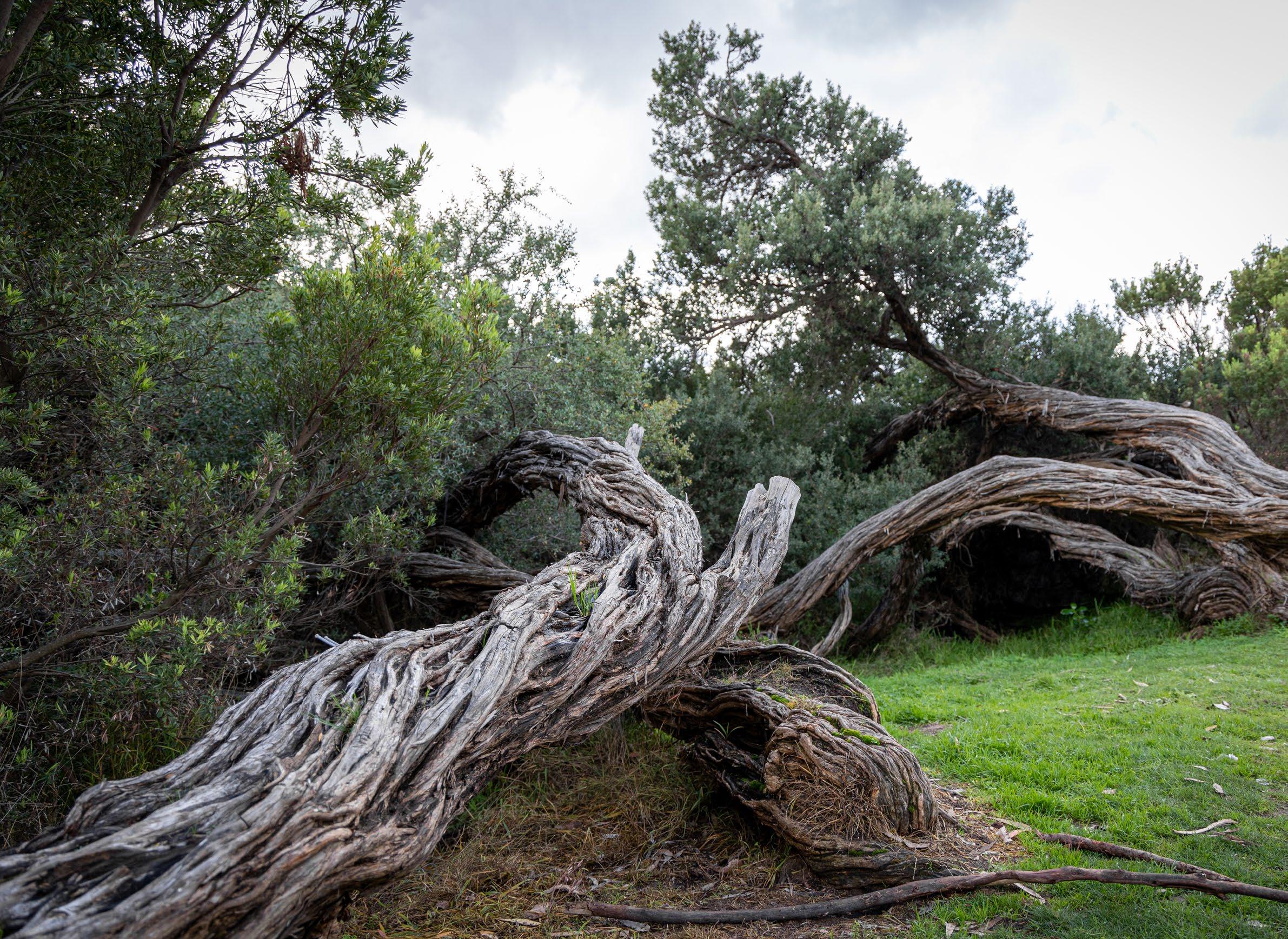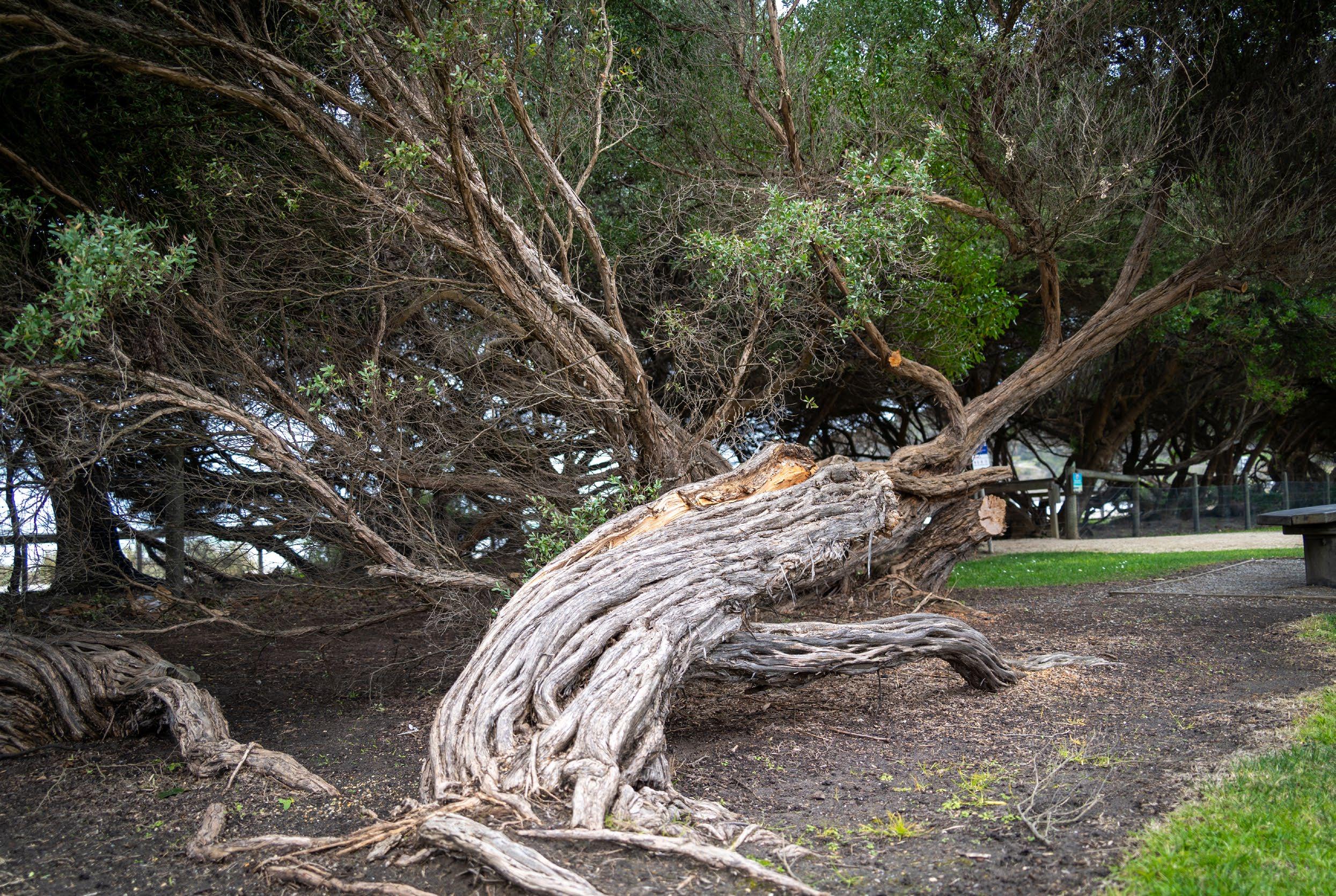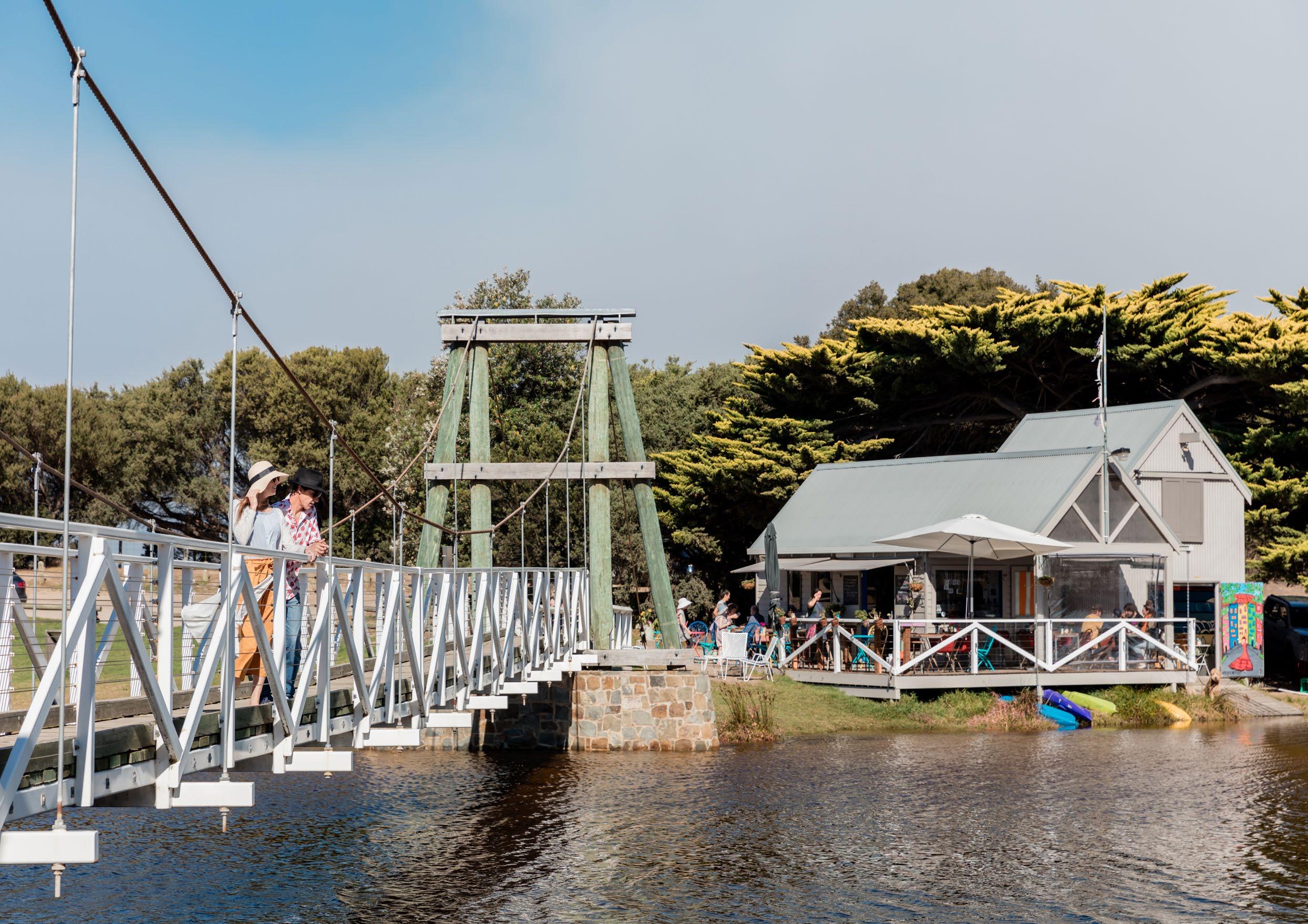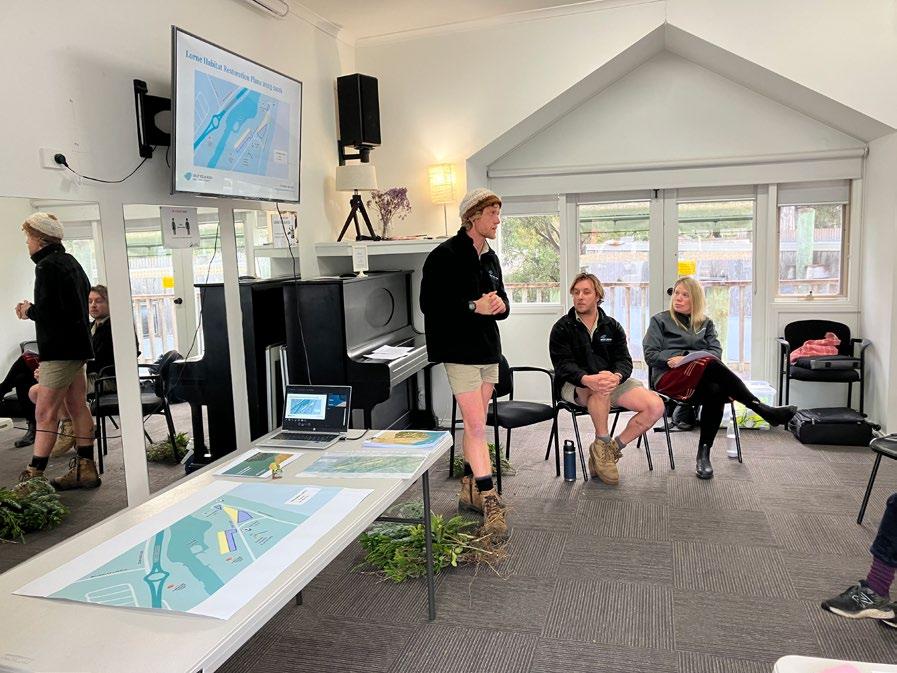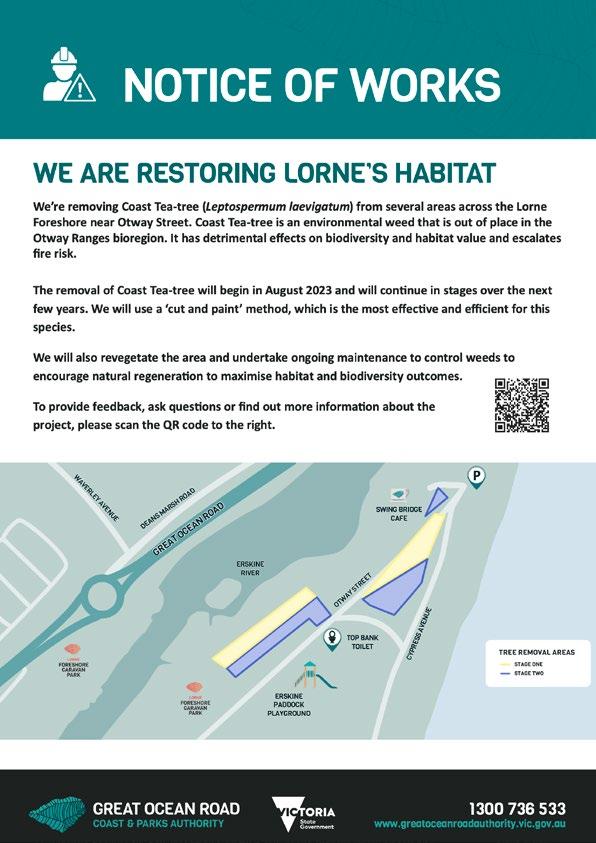KEY POINTS RAISED AND OUR RESPONSE
Community members expressed both concerns and support for the upcoming habitat restoration works, offering ideas on how we could better engage the community and disseminate information on habitat restoration in the future. Here is a summary of the key points raised:
THE REMOVAL OF COAST TEA-TREE
Feedback regarding the removal of Coast Tea-tree on the Lorne foreshore was mixed, as gleaned from community conversation sessions, survey responses, and emailed submissions.
Comments included:
“There is too much tea-tree dominating the coast. “
“We would like to express our strong opposition to the planned further removal of any coastal tea tree in Lorne.”

“Just leave it as is please.”
“I would like to see the removal of the tea tree on the Lorne Foreshore.”
Our response:
Guided by the Coastal Vegetation Strategy we manage the Great Ocean Road Coast and Parks as a landscape, rather than focusing on individual sites. To ensure habitat restoration at a landscape scale we will continue to remove woody weeds from across the land we manage Coast Tea-tree is the only woody weed remaining en mass in the Lorne foreshore area and therefore its removal is a key component of habitat restoration.
Continue the story. www.greatoceanroadauthority.vic.gov.au
INVOLVEMENT IN SITE REVEGETATION AND MAINTENANCE
75% of survey respondents said they would not like to be involved in looking after habitat restoration sites. The types of involvement people did express an interest in included taking part in planting days or site maintenance (5 people) and attending future community information sessions (3 people). The Friends of Lorne submission also highlighted that they would be interested in supporting monitoring of the restoration sites through a citizen science program.
Our response:
We’re delighted to see that some members of the Lorne community are eager to participate in habitat restoration efforts. We will integrate this preference into planning for future works through community information sessions, community planting days and investigating the potential for citizen science to contribute to monitoring the outcomes of habitat restoration works. A community planting day will be held on August 29, 2023, to revegetate the areas where Coast Tea-tree are to be removed earlier in August.
FUTURE COMMUNICATIONS ON HABITAT RESTORATION
The community feedback we received in 2022 was that the Lorne community wanted to know more about the habitat restoration works. Preferences for different methods of receiving information are shown in graph 2 below.
Comments included:
“It is commendable that information has been provided.”
Our response:
We will use this information to guide future communications with the Lorne community on habitat restoration works.
Continue the story. www.greatoceanroadauthority.vic.gov.au SOCIAL MEDIA ARTICLE IN THE SURF COAST TIMES ARTICLE IN THE LORNE INDEPENDENT SIGN AT THE SITE OF THE WORKS DIRECT EMAIL COMMUNITY INFORMATION SESSION OTHER 31.82% 50% 63.64% 59.09% 18.18% 23.64% 31.82%
IMPACTS ON FORESHORE AESTHETICS, AMENITIES, AND TIMING OF WORKS
Community feedback expressed considerable concern about the potential negative impacts on the aesthetics and amenities of the Lorne foreshore due to the restoration works. A solution suggested was to not remove Coast Tea-tree at all, or if it is removed to do it in a slower manner. Conversely, several respondents stated support for the removal of Coast Tea-tree as it will improve the amenity of the area, including providing better views. Some people also backed the staged approach we’re taking towards the restoration works.
Comments included:
“Any change that has a major effect on the current panorama must be handled carefully & at the appropriate speed.”
“Coastal Tea-tree is not an attractive tree, all the planting on the open foreshore of Lorne was to be low growing, so not to obstruct views from Mountjoy Parade. Sadly, this has not been the case and the views are totally obscured now.”
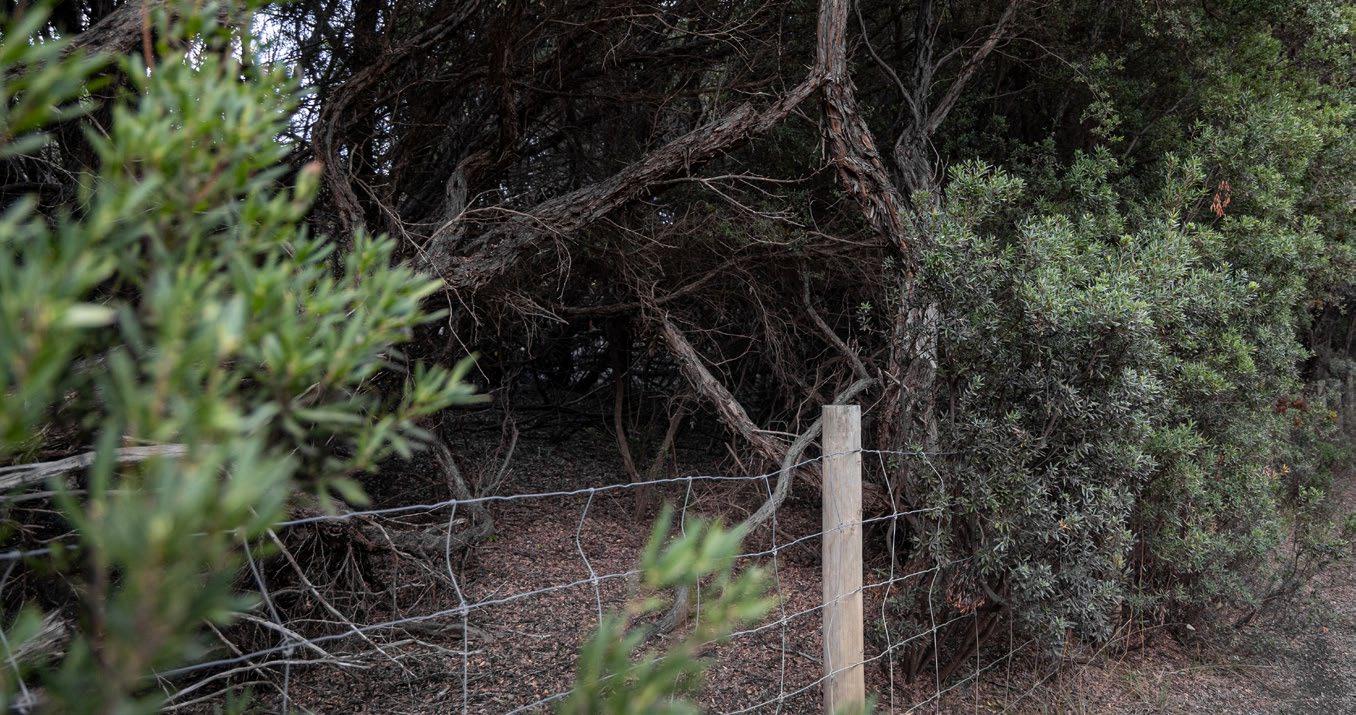
“These areas are part of the fabric of the history of Lorne. Used for play, used for art, used for shelter.”
“The amount of removal, while staged, risks changing the entire feel of area especially in the vicinity of the swing bridge.”
Our response:
The community’s feedback revealed some confusion about the areas from which Coast Tea-tree will be removed during the habitat restoration works. We want to reassure the community that we will not be removing Coast Tea-tree from the entire Lorne foreshore. We’ll only remove it from areas with conservation value as outlined in our Coastal Vegetation Strategy. Highly modified areas with little conservation value (particularly along Cypress Avenue to the Surf Life Saving Club) will not have Coast Tea-tree removed. We have updated our project map (see page 5 of this report) to clearly show where Coast Tea-tree will be removed and where it will not be removed.
We expect the canopy of the new vegetation to match the current Coast Tea-tree height within five years. All sites on the Lorne foreshore where we undertake large-scale woody weed removal are replanted using indigenous species. These species will support both ecological outcomes and community values through restoring habitat as well as providing the same or similar screening, windbreak, and shade functions that Coast Tea-tree now provides. CLICK HERE can see what a restored habitat site may look like.
Continue the story. www.greatoceanroadauthority.vic.gov.au
Our response continued:
We acknowledge there will be changes to the amenity value of this area of the Lorne foreshore where habitat restoration is occurring. These changes are welcome to some community members, but not to others. To alleviate the impacts of the change, we have amended the way we are conducting the works in a couple of ways:
• Prompt Replanting. Our standard approach after weed removal is to allow sites to naturally regenerate. However, in response to community concern about amenity impacts on the Lorne foreshore, we will begin replanting within a month after Coast Tea-tree removal. This will ensure the visual impact of weed removal is minimised as much as possible.
• Staging the works. To further reduce amenity impacts we are undertaking the habitat restoration works in a slower, staged manner. We’re pleased to have received some community feedback that supports this approach.
These stages are represented on the maps on page 2. Stage 1 of works will be undertaken in August 2023. The team will monitor regrowth at these sites and then look to implement Stage 2 of removal in future years. We will only activate Stage 2 once the rehabilitated area of Stage 1 reaches approximately 120cm in height. This process could take between one and three years, depending on climatic conditions.
HABITAT IMPACTS
There were concerns expressed in the feedback that removing Coast Tea-tree could result in a loss of animal habitats for species that currently depend on them. Several responses specifically highlighted that the works will likely have a detrimental impact on the threatened Rufous bristlebird and asked whether the Coast Teatree should be left because of the structure it provides. A few people suggested that the Authority should replace Coast Tea-tree as they die, rather than remove them all at once as planned for each stage.
Comments included:
“Please don’t remove healthy trees that are contributing to the natural environment of Lorne. It is totally unnecessary and just plain destructive. Develop a plan that replaces them as they die. Work with nature not against it.”
“GORCAPA are doing landscape cleanups, and invasive Tea tree has been nominated as a weed species that needs tending to.”
“I think it the height of human arrogance to dictate what native species should have the right to grow - to be there - while another should not.”
“Please don’t rush in to remove tea tree and other non-indigenous vegetation without full appreciation of the effects on wildlife and coastal erosion.”
Continue the story. www.greatoceanroadauthority.vic.gov.au
COASTAL EROSION AND CLIMATE CHANGE IMPACTS
A key concern expressed throughout the engagement process was that the restoration works would reduce the resilience of the Lorne foreshore to coastal erosive processes, such as high tides and storm events, that climate change may worsen.
Comments included:
“It will be difficult to safeguard the dunes along the coast at Lorne if all the non-indigenous vegetation is removed leaving it open to increased erosion.”
“Our overwhelming concern is for the minimisation of coastal erosion.”
“The coastal tea has a critical role in stabilise the foreshore, with climate change and higher sea levels and tides we must not be destabilising the foreshore based on the farcical claim the tea tree is a weed.”
Our response:
This habitat restoration program does not include the removal of vegetation from the primary dune system (dunes that are closest to the high tide mark and ocean). The primary dune system is the area of the coast that provides frontline protection from coastal processes. The map on page 5 shows the locations for removal.
We recognise the removal of some Coast Tea-tree from the embankment adjacent to the Erskine River Estuary may raise concerns. Whilst this area is not identified as an erosion point under the Planning and Environment Act 1987, we will employ a cut and paint removal method which maintains soil integrity whilst indigenous species establish.
Even though it’s not relevant to these specific habitat restoration areas, it’s worth noting that removing weeds from dunes and replacing with indigenous dune vegetation will recreate stronger, more resilient dune systems that can better adapt to coastal processes and a changing climate. A healthy, dynamic system will lose and gain sand, and the shape of dunes will change, in response to coastal conditions and processes.
WEED REMOVAL OBJECTIVES APPLIED ACROSS LORNE
Some community members asked questions in relation to the approach we are undertaking to remove Coast Tea-tree. There was uncertainty regarding the one-in-three approach outlined in the Coastal Vegetation Strategy.
Continue the story. www.greatoceanroadauthority.vic.gov.au
Our response:
Each site where we manage weeds is assessed based on amenity, conservation and cultural values. Based on this assessment, each site is prioritised assigned a low, medium or high priority ranking (see Part 1, page 24 of the Coastal Vegetation Strategy for a description). This prioritisation, coupled with individual site characteristics, inform our management approach.
The approach we are taking on the Lorne foreshore as identified in the map on page 5 is staged removal with immediate revegetation.
In North Lorne, our Coastal Vegetation Strategy states that 1 in 3 Coast Tea-tree will be removed. The objective is framed this way to achieve a 30%* reduction of Coast Tea-tree during the five-year period of the Coastal Vegetation Strategy and takes into consideration significant site constraints (namely accessibility and topography), current staff resourcing and a low priority rating. However, it is an ongoing objective, with the aim being that all Coast Tea-tree will be eradicated, not just 1 in 3.
To clarify, if three Coast Tea-tree are in a row, we are not removing 1 out of those 3. Rather, we are removing 30% across the site.
*The Coastal Vegetation Strategy objective for Coast Tea-tree is combined with Sallow Wattle. The fiveyear objective is to reduce Coast Tea-tree and Sallow Wattle by 40%. This reflects a 30% reduction of Coast Tea-tree and 10% of Sallow Wattle.
EVIDENCE AND MONITORING
EVIDENCE AND MONITORING
Some feedback appreciated the scientific basis for the works, while others stated that there was a lack of evidence to justify the works. Concern was expressed that without monitoring of the works it will be hard to measure their success in restoring habitat. It was suggested that we monitor the works, and that the community could potentially assist to resource monitoring via a citizen science monitoring program.
Comments included:
“GORCAPA has limited resources, which is a continuing concern for us. We note the organisation’s need to rely on goodwill and partnerships for ongoing research and essential data gathering. We would like the type of evidence that you have to evaluate the impact of your strategy here to match what you have in Aireys Inlet.”
on goodwill and partnerships for ongoing research and essential data gathering. We would like the type of
“The GORCAPA coastal veg people do a good job within their constraints, and that their thinking on ecological matters is in keeping with science and developing practice.”
“Are you basing this scheme on previously successful ventures or is this entirely experimental with no known outcome?”
Continue the story. www.greatoceanroadauthority.vic.gov.au
Our response:
Through our engagement we have shared the scientific basis for the works and provided external sources on which our strategic documents and policies are based. We work to the best scientific data and methodology available at the time and will adapt and change our methodology if, and when more accurate information becomes available. This also includes learnings our staff uncover as they undertake works across our management estate.
Coast Tea-tree removal has been conducted across this coastline for over 25 years. Our Conservation team and community conservation groups have observed a significant increase in habitat diversity, and consequently increase in indigenous fauna to areas where Coast Tea-tree is removed and indigenous vegetation reinstated. There are many examples of this across our coast, you can reference in this video.
We acknowledge that there has been a lack of monitoring of our conservation works to date. We are establishing a protocol for monitoring works that will be replicable across habitat restoration sites.
For the upcoming Coast Tea-tree removal works, we’re initiating a flora monitoring program which will capture the changes in vegetation over time. This will help Authority staff and the community better understand the changes that occur through habitat restoration. We’ll share monitoring results on our website.
We’re also developing a fauna monitoring program. This work will help us monitor the impact of works such as Coast Tea-tree removal on endangered and threatened animal species that depend on indigenous habitat.
Citizen science would be a valuable contribution to increasing our understanding and providing critical data. We’re happy to work with any local community groups to explore this option for monitoring data collection.
HOW WE ENGAGED WITH YOU
Several participants appreciated the increase in engagement in 2023 with the Lorne community on the habitat restoration works. However, some felt that the level and type of consultation was not sufficient. Frustration was expressed that we were not engaging to allow for the community to decide whether Coast Tea-tree is to be removed or not.
Feedback at the community conversation sessions indicated that the knowledge shared by Authority staff and the chance to be listened to was appreciated. However, some attendees felt disappointed they could not influence whether or not the habitat restoration works would occur.
Several survey responses noted an improvement in the 2023 engagement approach, conducted before the Coast Tea-tree removal, compared to the engagement process in 2022, which occurred after the Coast Tea-tree removal. Some people expressed their thanks to the Friends of Lorne who have worked hard to disseminate information on the works with their members and the wider Lorne community.
Continue the story. www.greatoceanroadauthority.vic.gov.au
Comments included:
“We appreciate how, in response to community concern, GORCAPA has gone the extra mile to increase the amount of information flow to the community in Lorne.”
“I find I am disenfranchised. When at a meeting to discuss the issue the audience is presented with a note for more removal.”
“Not sure why it is needed and have not seen clearly put propositions on maps and with photos by GORCAPA”.
Our response:
We appreciate the broad and frank feedback on the way we have engaged on habitat restoration works in Lorne. This feedback helps us as an organisation to better understand the way that the Lorne community would like to be engaged on works that impact coastal vegetation and the associated community held values.
We’re grateful to the community members who participated in this engagement process and to the Friends of Lorne for generous assistance in disseminating and sharing information among their networks. In response to the community’s suggestion for more accessibility, we’ll ensure future engagements include both online and in-person community conversations. The habitat restoration works we are undertaking on the Lorne foreshore are guided by the Coastal Vegetation Strategy. This strategy was developed through its own robust community and stakeholder engagement process. This is why (combined with using best practice and independent conservation methodology) throughout this engagement process we have not asked the community whether we should or should not do the works. We’ve focussed on sharing knowledge about habitat restoration, understanding and hopefully easing community confusion and concerns. We have also sought to better understand how the community wishes to receive communications on habitat restoration works and be involved in site maintenance and revegetation works. We apologise if community members were confused as to the engagement purpose.
We’re pleased to see that our 2023 engagement approach is viewed as a better fit for the Lorne community than our 2022 approach. This new approach was implemented in response to community feedback on our 2022 engagement.
NEXT STEPS
Your valuable input has helped us shape a habitat restoration program which better meets the Lorne community’s needs. In mid-August 2023 we’ll conduct habitat monitoring of the Stage 1 project sites and then remove Coast Tea-tree. In September 2023 we will host a community planting day to revegetate the sites. In line with community feedback on communication preferences, we’ll share information on these activities via social media, site signage, the Surf Coast Times and the Lorne Independent.
Our Conservation Team will monitor and maintain the revegetated sites. We’ll keep the community informed about the monitoring results and any further habitat restoration to be undertaken at Stage 2 sites over the coming years.
REFERENCES
E. Mitchell and B.A. Wilson (2007), Detection and habitat use of the Rufous Bristlebird (Dasyornis broadbenti) in coastal heathland, in south-western Victoria, Australia, Emu-Austral Ornithology, 107:4, 327-334.
Continue the story. www.greatoceanroadauthority.vic.gov.au

Get in touch If you have further questions about this project, please visit the Have Your Say webpage The project team can be contacted at: haveyoursay@GreatOceanRoadAuthority.vic.gov.au
